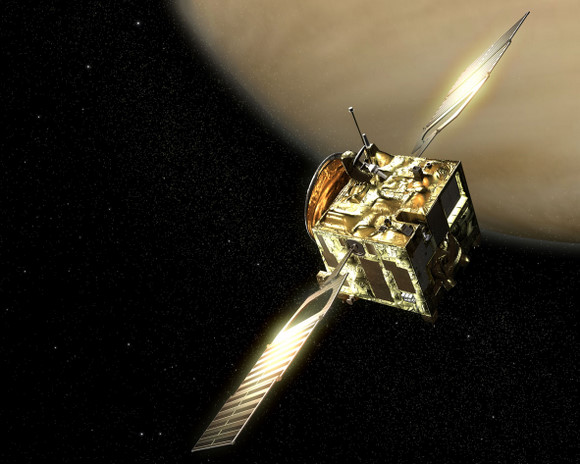ESA’s Venus Express spacecraft will be cozying up to the planet it has been studying for over two years to begin new and more detailed observations of Venus. This week, engineers began executing a series of maneuvers to gradually bring the spacecraft to a new orbit, closer to Venus. In its new, modified orbit the spacecraft will be able to observe unexplored regions and investigate phenomena that were not within its reach before. The maneuvers will be executed through the month of July, settling it into its new orbit by August 4. Venus Express will eventually get close enough to the planet to dip slightly into the atmosphere, testing out its aerobraking capabilities to further alter its orbit, as well as evaluating the density of the upper atmosphere by measuring the drag on the spacecraft with its on-board accelerometers.
Until now, Venus Express has occupied a highly eccentric polar orbit: at its closest point (pericentre), the spacecraft is between 250 km and 400 km from the planet, and at its farthest (apocentre), it is about 66,000 km away. The pericentre is located at 84° north.

This eccentric orbit was designed to facilitate observation of the southern hemisphere for extended periods, while being able to obtain close observations of northern hemisphere and northern polar regions.
The lowering of the Venus Express orbit is the first step in for more ambitious explorations of Venus, especially of its atmosphere.
Venus Express has already found a highly variable quantity of the volcanic gas sulphur dioxide in the atmosphere of the planet. Scientists are trying to determine if this is evidence for active volcanoes on Venus, or by another unknown mechanism affecting the upper atmosphere.
Now, the altitude of the pericentre will now be lowered to between 185 and 300 km. This modification will enable the following science advantages:
• Study of the magnetic field in the northern polar region
• Study of the plasma environment deeper in the ionosphere
• To indirectly deduce the density of the planet’s atmosphere by measuring the force, or drag, exerted by the planet’s atmosphere on the body of the spacecraft as it moves closer to the planet
Venus Express is European Space Agency’s first mission to Venus. Launched in November 2005, the spacecraft arrived at the planet on 11 April 2006 and began science observations within a month. Since then, it has continuously been making new discoveries and revising our knowledge of Venus.
As of April of this year the spacecraft had returned over 1277 gigabits of data to Earth.


There’s something about this mission that just never inspired me like almost every other space mission does. I think it has something to do with the fact that the team is HOPELESS at communicating their findings to the public; you simply never hear a peep from them, even on the main mission website.
It’s disappointing, because pre-launch I was looking forward to it with great anticipation. Doubly disappointing, because the science is of a very high quality, and quite ground-breaking.
I gotta agree with Astrofiend. We don’t hear much about Venus even though it’s closer and far more dynamic then Mars. My guess is that it will probably never host a human visitor.
How does the ESA mission differ from the JPL/Hughes Space and Comm mission 2(?) decades ago, which pioneered aerobraking to circularize and reduce the orbit to enable radar imaging of Venus? I believe the north polar region was a prime target of that mission.
Al